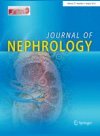Efficacy of low or standard rituximab-based protocols and comparison to Ponticelli’s regimen in membranous nephropathy
Abstract
Background
Patients (pts) with primary Membranous nephropathy (MN) have an autoimmune disease caused by autoantibodies against podocyte antigens and 60-80% of them have antibodies directed against the M-type phospholipase A2 receptor (PLA2R). Immunosuppressive treatment is recommended in high-medium risk pts. Recently the use of rituximab (RTX), has emerged as an important therapeutic option in pts with primary MN. The appropriate cumulative dose of RTX in PMN pts is still uncertain, and favorable outcomes even with low-dose of RTX has been described. We compared efficacy and safety of 3 different treatment regimens: low-dose RTX (Protocol 1, one dose of RTX 375 mg/m2), standard RTX protocol (Protocol 2, four weekly doses of rituximab 375 mg/m2) and Ponticelli’s regimen.
Methods
42 pts with primary MN and nephrotic syndrome were assigned to Protocol 1 (14 pts) or Protocol 2 (14 pts). All patients were followed for 24 months after RTX. Fourteen pts, matched for age and baseline serum creatinine (sCr) and proteinuria, treated with Ponticelli’s regimen were examined as controls.
Results
At 24 months, a significant improvement in proteinuria levels was observed in pts treated with Protocol 1 (7.5 ± 4.8 at T0; 0.21 ± 0.15 at T24, p < 0.01), Protocol 2 (5.1 ± 1.41 g/24 at T0; 0.35 ± 0.39 at T24 p < 0.01) and controls (8.27 ± 4.78 T0; 2.2 ± 1.9 g/24 h at T24, p < 0.01). No differences in clinical response (p = 0.53) was observed comparing the 3 groups.
Conclusions
Our data suggest that the RTX is a promising alternative to Ponticelli’s regimen even at low-doses. This makes RTX a cost-effective treatment of primary MN in the short and medium terms.



